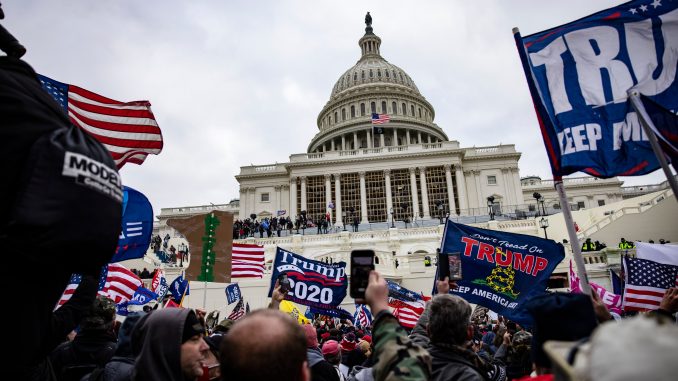
More than 30,000 voters who had been registered members of the Republican Party have changed their voter registration in the weeks after a mob of pro-Trump supporters attacked the Capitol — an issue that led the House to impeach the former president for inciting the violence.
The massive wave of defections is a virtually unprecedented exodus that could spell trouble for a party that is trying to find its way after losing the presidential race and the Senate majority.
It could also represent the tip of a much larger iceberg: The 30,000 who have left the Republican Party reside in just a few states that report voter registration data, and information about voters switching between parties, on a weekly basis.
Voters switching parties is not unheard of, but the data show that in the first weeks of the year, far more Republicans have changed their voter registrations than Democrats. Many voters are changing their affiliation in key swing states that were at the heart of the battle for the White House and control of Congress.
Nearly 10,000 Pennsylvania voters dropped out of the Republican Party in the first 25 days of the year, according to the secretary of state’s office. About a third of them, 3,476, have registered as Democrats; the remaining two-thirds opted to register with another party or without any party affiliation.
By contrast, about a third as many Pennsylvania Democrats opted to either join the Republican Party (2,093 through Monday) or to register with no party or a minor party (1,184).
Almost 6,000 North Carolina voters have dropped their affiliation with the GOP. Nearly 5,000 Arizona voters are no longer registered Republicans. The number of defectors in Colorado stands north of 4,500 in the last few weeks. And 2,300 Maryland Republicans are now either unaffiliated or registered with the Democratic Party.
In all of those areas, the number of Democrats who left their party is a fraction of the number of Republican defectors.
Several local elections offices in Florida reported a surge in registration changes in the days after the assault on the Capitol. Two counties in the Miami area reported a combined 1,000 Republicans registering under other labels in just the two days after the Jan. 6 attack. In those same two days, only 96 Democrats switched parties.
Three counties in the Tampa Bay area reported more than 2,000 Republican voters registering under some other party’s banner. In those same three counties — Hillsborough, Pasco and Pinellas — just 306 Democrats switched their affiliations.
So many voters switching parties absent a pending deadline has piqued the interest of elections experts. Most people tend to stick with the party with which they initially register, and those who do change are usually motivated by a looming primary election.
“Usually, absent a primary election that would induce people to switch parties so that they could participate in that primary, you don’t see much activity in party registration,” said Michael McDonald, a voting and elections expert at the University of Florida.
Only a small handful of states report voter registration data on a weekly basis. Others report monthly activity, and many states do not report granular details about those who leave one party or the other. Once more states report party registration data, the true number of Republicans who have re-registered in recent weeks may prove to be much higher.
McDonald said those who would take the proactive step to change their registration are likely to be well-informed voters who both follow the news and are aware of the process by which they would change their actual registration.
“These people who are doing this activity, they are likely very sophisticated voters. They’re highly participatory, most likely,” he said. “If you’re sophisticated enough to change your party registration, you’re somebody who’s likely to vote.”
Some of the data suggests the Republican exodus is happening in the suburban counties where GOP candidates and former President Trump struggled so much in both the 2018 and 2020 elections.
About a third of the Pennsylvania voters who dropped their affiliation with the Republican Party are registered to vote in Montgomery, Bucks, Chester and Delaware counties, the so-called Collar Counties outside of Philadelphia that once decided the balance of power in the Keystone State. Those counties have trended increasingly Democratic in recent years; President Biden won 58 percent of the vote in Chester County, the best performance ever recorded by a Democratic candidate there.
By contrast, Republicans picked up more former Democratic voters in places like Berks, Luzerne and Cambria counties, exurban and rural areas where Trump did better than previous Republican nominees.
Trump scored 68 percent of the vote in Cambria County, home of Johnstown and ancestral Democrats once represented in Congress by Rep. John Murtha (D). That tally was better than any previous Republican nominee, besting even the 66.5 percent Trump won there in 2016.
McDonald cautioned that the number of voters switching parties overall was relatively small — the 10,000 Republicans who fled in Pennsylvania represents a tiny fraction of the party’s almost 3.5 million registered voters in the state, for example. But the figures represent a reversal of registration trends that were taking place before Election Day.
“Prior to the election, the trend was in the opposite direction, there were more Republicans that were registering,” McDonald said. “It’s not just like it’s a little blip, it’s also a blip in a different direction than we’ve seen in previous years.”
Via The Hill
